International Marketing Report: PepsiCo Expansion Strategies
VerifiedAdded on 2021/01/02
|12
|3213
|242
Report
AI Summary
This report provides a comprehensive analysis of PepsiCo's international marketing strategies, examining its expansion into global markets. It begins with an introduction to international marketing, defining key concepts and outlining the scope of the subject. The report then explores the rationale behind PepsiCo's international marketing efforts, highlighting opportunities such as increased sales and profits, along with the challenges faced, including tariff barriers and political instability. The core of the report focuses on applying key criteria for market selection, detailing the analytical processes involved. It also evaluates different entry strategies, such as exporting, joint ventures, and licensing, weighing their advantages and disadvantages. The report further addresses the adoption of local versus global approaches and the adaptation of the marketing mix (product, price, promotion, and place) in various international markets. Finally, the report concludes with an evaluation of PepsiCo's international marketing approaches and a comparison of home and international orientation.
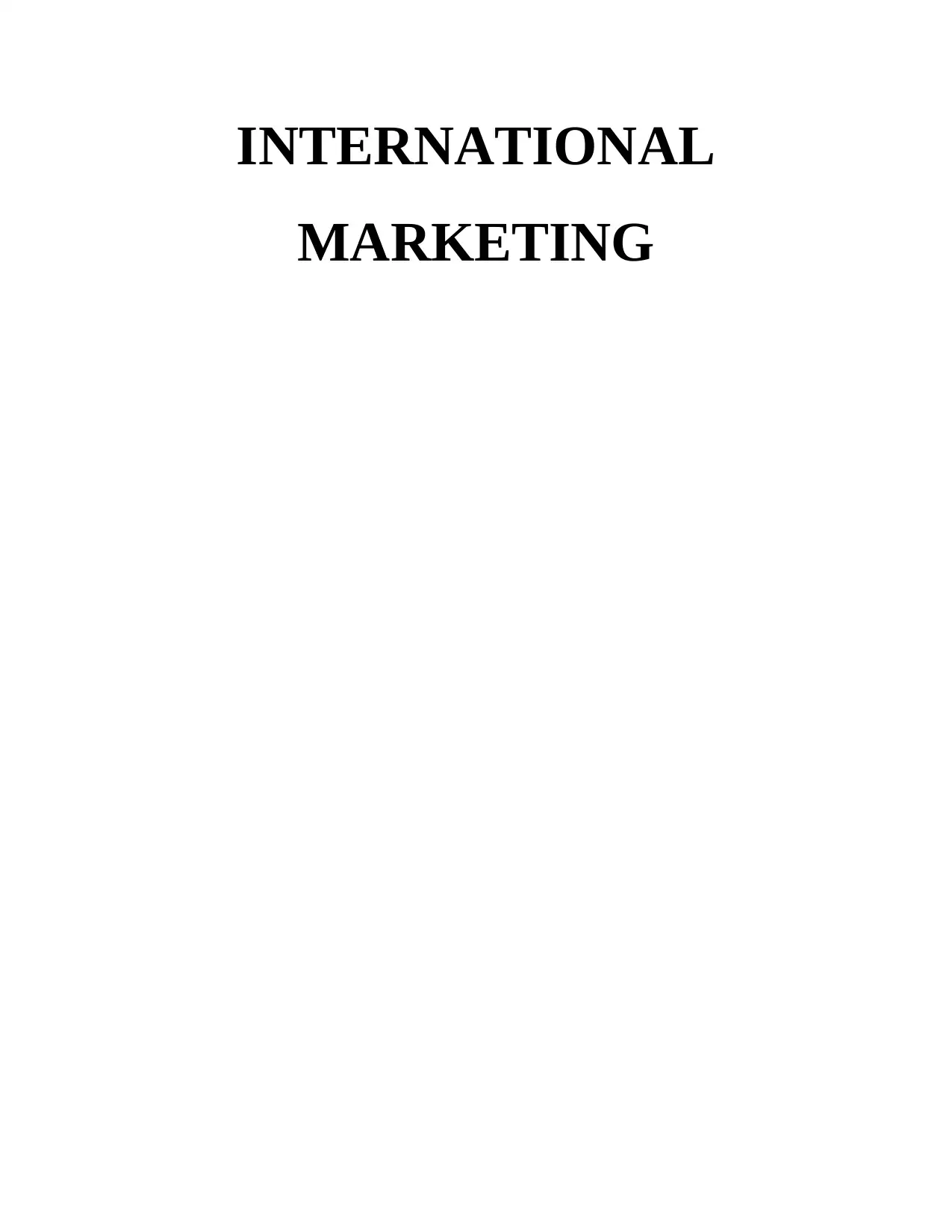
INTERNATIONAL
MARKETING
MARKETING
Paraphrase This Document
Need a fresh take? Get an instant paraphrase of this document with our AI Paraphraser
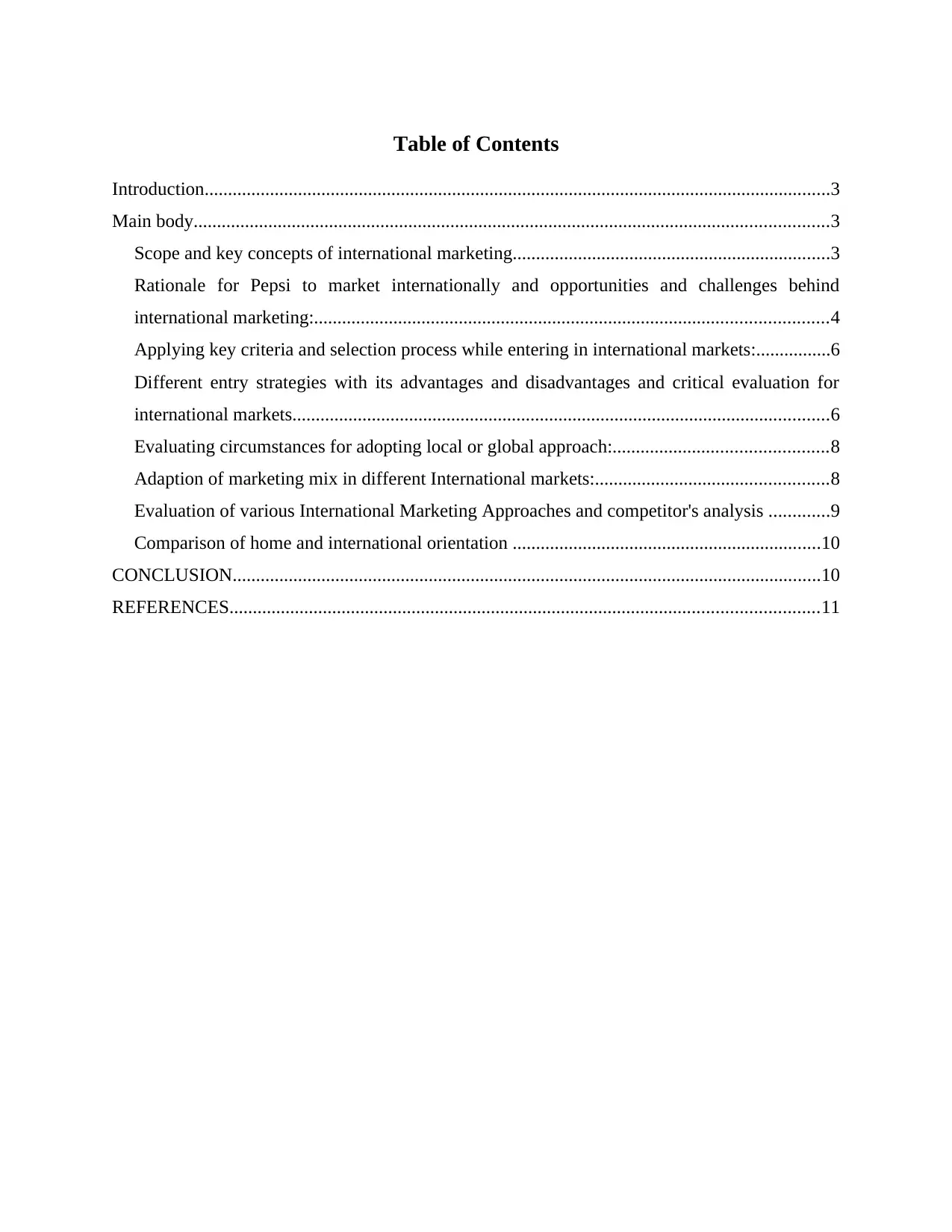
Table of Contents
Introduction......................................................................................................................................3
Main body........................................................................................................................................3
Scope and key concepts of international marketing....................................................................3
Rationale for Pepsi to market internationally and opportunities and challenges behind
international marketing:..............................................................................................................4
Applying key criteria and selection process while entering in international markets:................6
Different entry strategies with its advantages and disadvantages and critical evaluation for
international markets...................................................................................................................6
Evaluating circumstances for adopting local or global approach:..............................................8
Adaption of marketing mix in different International markets:..................................................8
Evaluation of various International Marketing Approaches and competitor's analysis .............9
Comparison of home and international orientation ..................................................................10
CONCLUSION..............................................................................................................................10
REFERENCES..............................................................................................................................11
Introduction......................................................................................................................................3
Main body........................................................................................................................................3
Scope and key concepts of international marketing....................................................................3
Rationale for Pepsi to market internationally and opportunities and challenges behind
international marketing:..............................................................................................................4
Applying key criteria and selection process while entering in international markets:................6
Different entry strategies with its advantages and disadvantages and critical evaluation for
international markets...................................................................................................................6
Evaluating circumstances for adopting local or global approach:..............................................8
Adaption of marketing mix in different International markets:..................................................8
Evaluation of various International Marketing Approaches and competitor's analysis .............9
Comparison of home and international orientation ..................................................................10
CONCLUSION..............................................................................................................................10
REFERENCES..............................................................................................................................11
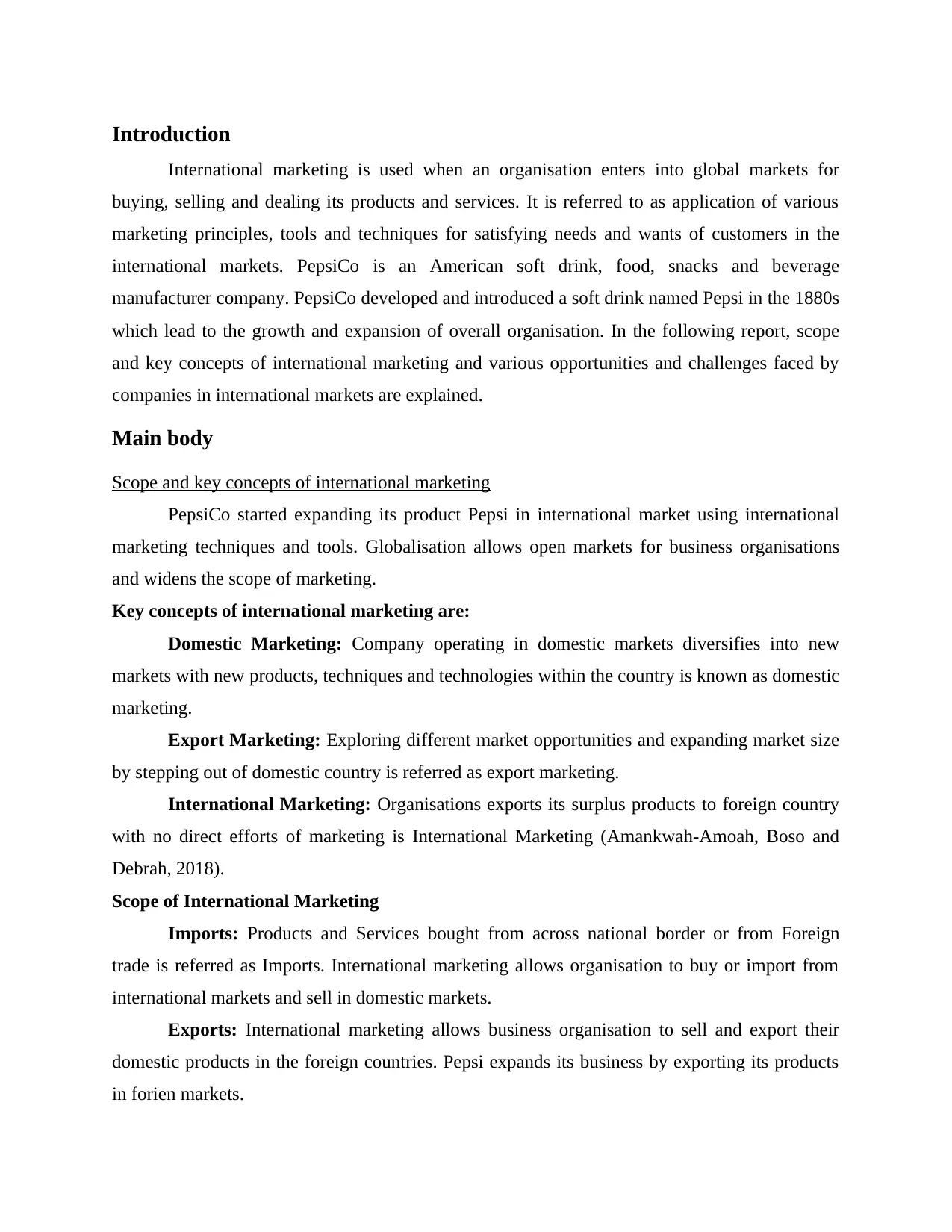
Introduction
International marketing is used when an organisation enters into global markets for
buying, selling and dealing its products and services. It is referred to as application of various
marketing principles, tools and techniques for satisfying needs and wants of customers in the
international markets. PepsiCo is an American soft drink, food, snacks and beverage
manufacturer company. PepsiCo developed and introduced a soft drink named Pepsi in the 1880s
which lead to the growth and expansion of overall organisation. In the following report, scope
and key concepts of international marketing and various opportunities and challenges faced by
companies in international markets are explained.
Main body
Scope and key concepts of international marketing
PepsiCo started expanding its product Pepsi in international market using international
marketing techniques and tools. Globalisation allows open markets for business organisations
and widens the scope of marketing.
Key concepts of international marketing are:
Domestic Marketing: Company operating in domestic markets diversifies into new
markets with new products, techniques and technologies within the country is known as domestic
marketing.
Export Marketing: Exploring different market opportunities and expanding market size
by stepping out of domestic country is referred as export marketing.
International Marketing: Organisations exports its surplus products to foreign country
with no direct efforts of marketing is International Marketing (Amankwah-Amoah, Boso and
Debrah, 2018).
Scope of International Marketing
Imports: Products and Services bought from across national border or from Foreign
trade is referred as Imports. International marketing allows organisation to buy or import from
international markets and sell in domestic markets.
Exports: International marketing allows business organisation to sell and export their
domestic products in the foreign countries. Pepsi expands its business by exporting its products
in forien markets.
International marketing is used when an organisation enters into global markets for
buying, selling and dealing its products and services. It is referred to as application of various
marketing principles, tools and techniques for satisfying needs and wants of customers in the
international markets. PepsiCo is an American soft drink, food, snacks and beverage
manufacturer company. PepsiCo developed and introduced a soft drink named Pepsi in the 1880s
which lead to the growth and expansion of overall organisation. In the following report, scope
and key concepts of international marketing and various opportunities and challenges faced by
companies in international markets are explained.
Main body
Scope and key concepts of international marketing
PepsiCo started expanding its product Pepsi in international market using international
marketing techniques and tools. Globalisation allows open markets for business organisations
and widens the scope of marketing.
Key concepts of international marketing are:
Domestic Marketing: Company operating in domestic markets diversifies into new
markets with new products, techniques and technologies within the country is known as domestic
marketing.
Export Marketing: Exploring different market opportunities and expanding market size
by stepping out of domestic country is referred as export marketing.
International Marketing: Organisations exports its surplus products to foreign country
with no direct efforts of marketing is International Marketing (Amankwah-Amoah, Boso and
Debrah, 2018).
Scope of International Marketing
Imports: Products and Services bought from across national border or from Foreign
trade is referred as Imports. International marketing allows organisation to buy or import from
international markets and sell in domestic markets.
Exports: International marketing allows business organisation to sell and export their
domestic products in the foreign countries. Pepsi expands its business by exporting its products
in forien markets.
⊘ This is a preview!⊘
Do you want full access?
Subscribe today to unlock all pages.

Trusted by 1+ million students worldwide
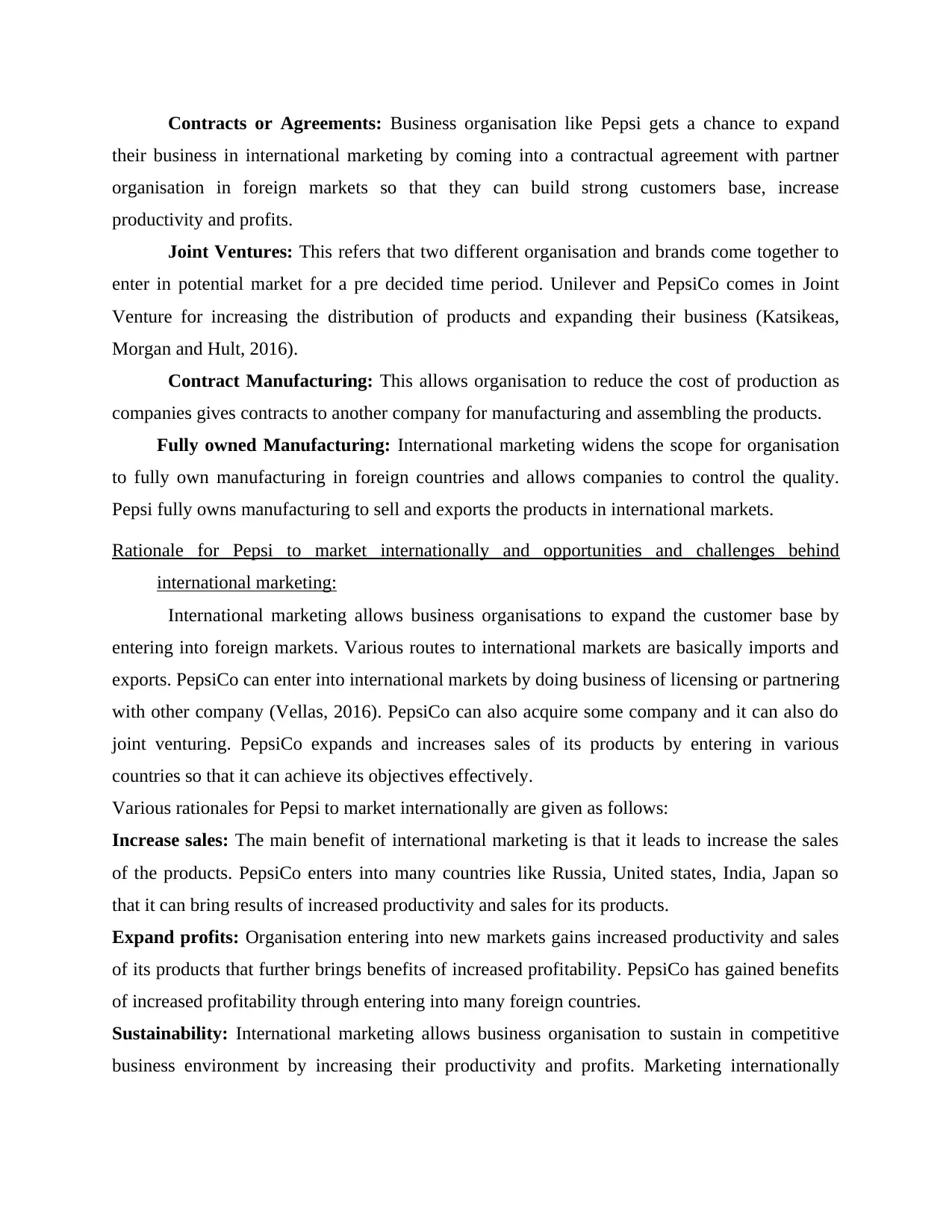
Contracts or Agreements: Business organisation like Pepsi gets a chance to expand
their business in international marketing by coming into a contractual agreement with partner
organisation in foreign markets so that they can build strong customers base, increase
productivity and profits.
Joint Ventures: This refers that two different organisation and brands come together to
enter in potential market for a pre decided time period. Unilever and PepsiCo comes in Joint
Venture for increasing the distribution of products and expanding their business (Katsikeas,
Morgan and Hult, 2016).
Contract Manufacturing: This allows organisation to reduce the cost of production as
companies gives contracts to another company for manufacturing and assembling the products.
Fully owned Manufacturing: International marketing widens the scope for organisation
to fully own manufacturing in foreign countries and allows companies to control the quality.
Pepsi fully owns manufacturing to sell and exports the products in international markets.
Rationale for Pepsi to market internationally and opportunities and challenges behind
international marketing:
International marketing allows business organisations to expand the customer base by
entering into foreign markets. Various routes to international markets are basically imports and
exports. PepsiCo can enter into international markets by doing business of licensing or partnering
with other company (Vellas, 2016). PepsiCo can also acquire some company and it can also do
joint venturing. PepsiCo expands and increases sales of its products by entering in various
countries so that it can achieve its objectives effectively.
Various rationales for Pepsi to market internationally are given as follows:
Increase sales: The main benefit of international marketing is that it leads to increase the sales
of the products. PepsiCo enters into many countries like Russia, United states, India, Japan so
that it can bring results of increased productivity and sales for its products.
Expand profits: Organisation entering into new markets gains increased productivity and sales
of its products that further brings benefits of increased profitability. PepsiCo has gained benefits
of increased profitability through entering into many foreign countries.
Sustainability: International marketing allows business organisation to sustain in competitive
business environment by increasing their productivity and profits. Marketing internationally
their business in international marketing by coming into a contractual agreement with partner
organisation in foreign markets so that they can build strong customers base, increase
productivity and profits.
Joint Ventures: This refers that two different organisation and brands come together to
enter in potential market for a pre decided time period. Unilever and PepsiCo comes in Joint
Venture for increasing the distribution of products and expanding their business (Katsikeas,
Morgan and Hult, 2016).
Contract Manufacturing: This allows organisation to reduce the cost of production as
companies gives contracts to another company for manufacturing and assembling the products.
Fully owned Manufacturing: International marketing widens the scope for organisation
to fully own manufacturing in foreign countries and allows companies to control the quality.
Pepsi fully owns manufacturing to sell and exports the products in international markets.
Rationale for Pepsi to market internationally and opportunities and challenges behind
international marketing:
International marketing allows business organisations to expand the customer base by
entering into foreign markets. Various routes to international markets are basically imports and
exports. PepsiCo can enter into international markets by doing business of licensing or partnering
with other company (Vellas, 2016). PepsiCo can also acquire some company and it can also do
joint venturing. PepsiCo expands and increases sales of its products by entering in various
countries so that it can achieve its objectives effectively.
Various rationales for Pepsi to market internationally are given as follows:
Increase sales: The main benefit of international marketing is that it leads to increase the sales
of the products. PepsiCo enters into many countries like Russia, United states, India, Japan so
that it can bring results of increased productivity and sales for its products.
Expand profits: Organisation entering into new markets gains increased productivity and sales
of its products that further brings benefits of increased profitability. PepsiCo has gained benefits
of increased profitability through entering into many foreign countries.
Sustainability: International marketing allows business organisation to sustain in competitive
business environment by increasing their productivity and profits. Marketing internationally
Paraphrase This Document
Need a fresh take? Get an instant paraphrase of this document with our AI Paraphraser
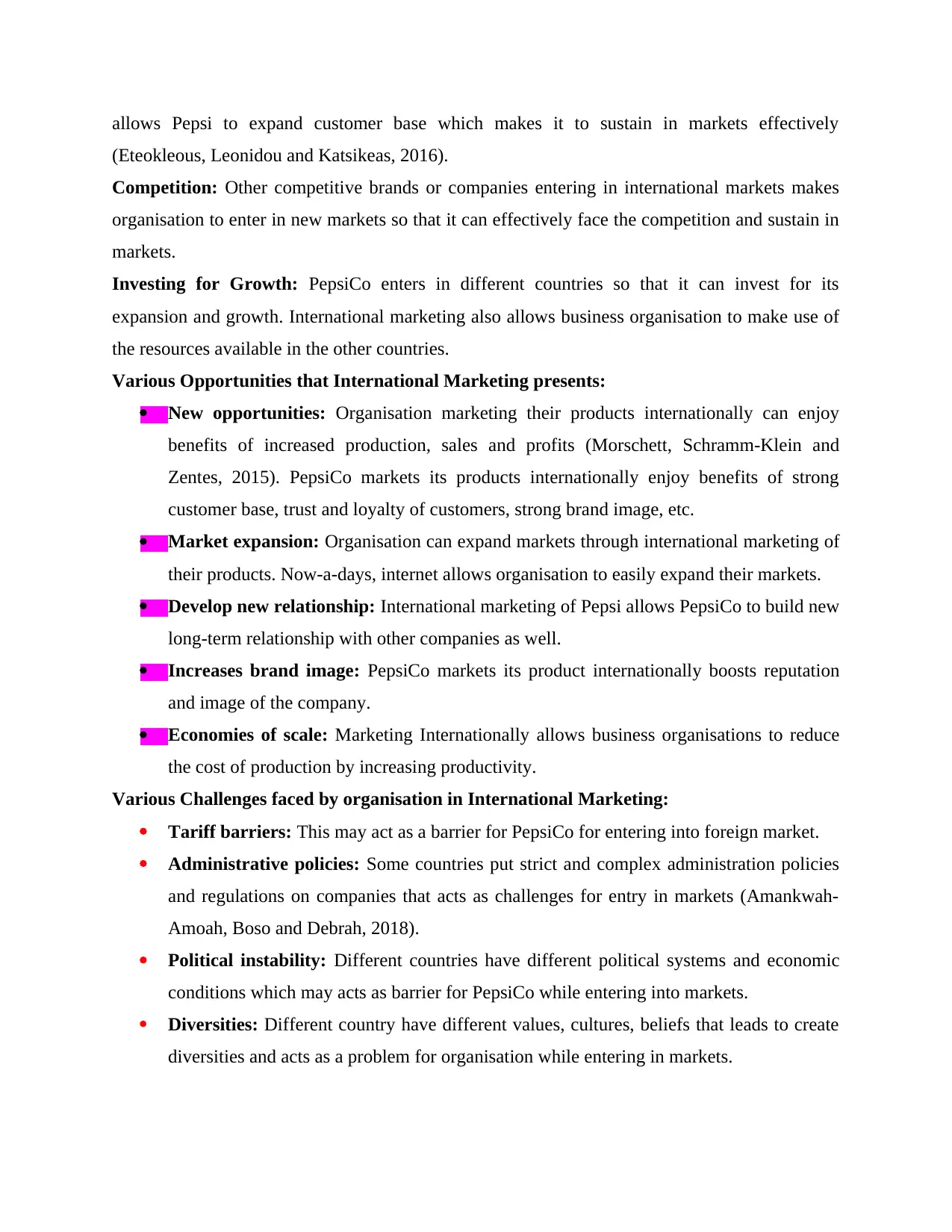
allows Pepsi to expand customer base which makes it to sustain in markets effectively
(Eteokleous, Leonidou and Katsikeas, 2016).
Competition: Other competitive brands or companies entering in international markets makes
organisation to enter in new markets so that it can effectively face the competition and sustain in
markets.
Investing for Growth: PepsiCo enters in different countries so that it can invest for its
expansion and growth. International marketing also allows business organisation to make use of
the resources available in the other countries.
Various Opportunities that International Marketing presents:
New opportunities: Organisation marketing their products internationally can enjoy
benefits of increased production, sales and profits (Morschett, Schramm-Klein and
Zentes, 2015). PepsiCo markets its products internationally enjoy benefits of strong
customer base, trust and loyalty of customers, strong brand image, etc.
Market expansion: Organisation can expand markets through international marketing of
their products. Now-a-days, internet allows organisation to easily expand their markets.
Develop new relationship: International marketing of Pepsi allows PepsiCo to build new
long-term relationship with other companies as well.
Increases brand image: PepsiCo markets its product internationally boosts reputation
and image of the company.
Economies of scale: Marketing Internationally allows business organisations to reduce
the cost of production by increasing productivity.
Various Challenges faced by organisation in International Marketing:
Tariff barriers: This may act as a barrier for PepsiCo for entering into foreign market.
Administrative policies: Some countries put strict and complex administration policies
and regulations on companies that acts as challenges for entry in markets (Amankwah-
Amoah, Boso and Debrah, 2018).
Political instability: Different countries have different political systems and economic
conditions which may acts as barrier for PepsiCo while entering into markets.
Diversities: Different country have different values, cultures, beliefs that leads to create
diversities and acts as a problem for organisation while entering in markets.
(Eteokleous, Leonidou and Katsikeas, 2016).
Competition: Other competitive brands or companies entering in international markets makes
organisation to enter in new markets so that it can effectively face the competition and sustain in
markets.
Investing for Growth: PepsiCo enters in different countries so that it can invest for its
expansion and growth. International marketing also allows business organisation to make use of
the resources available in the other countries.
Various Opportunities that International Marketing presents:
New opportunities: Organisation marketing their products internationally can enjoy
benefits of increased production, sales and profits (Morschett, Schramm-Klein and
Zentes, 2015). PepsiCo markets its products internationally enjoy benefits of strong
customer base, trust and loyalty of customers, strong brand image, etc.
Market expansion: Organisation can expand markets through international marketing of
their products. Now-a-days, internet allows organisation to easily expand their markets.
Develop new relationship: International marketing of Pepsi allows PepsiCo to build new
long-term relationship with other companies as well.
Increases brand image: PepsiCo markets its product internationally boosts reputation
and image of the company.
Economies of scale: Marketing Internationally allows business organisations to reduce
the cost of production by increasing productivity.
Various Challenges faced by organisation in International Marketing:
Tariff barriers: This may act as a barrier for PepsiCo for entering into foreign market.
Administrative policies: Some countries put strict and complex administration policies
and regulations on companies that acts as challenges for entry in markets (Amankwah-
Amoah, Boso and Debrah, 2018).
Political instability: Different countries have different political systems and economic
conditions which may acts as barrier for PepsiCo while entering into markets.
Diversities: Different country have different values, cultures, beliefs that leads to create
diversities and acts as a problem for organisation while entering in markets.
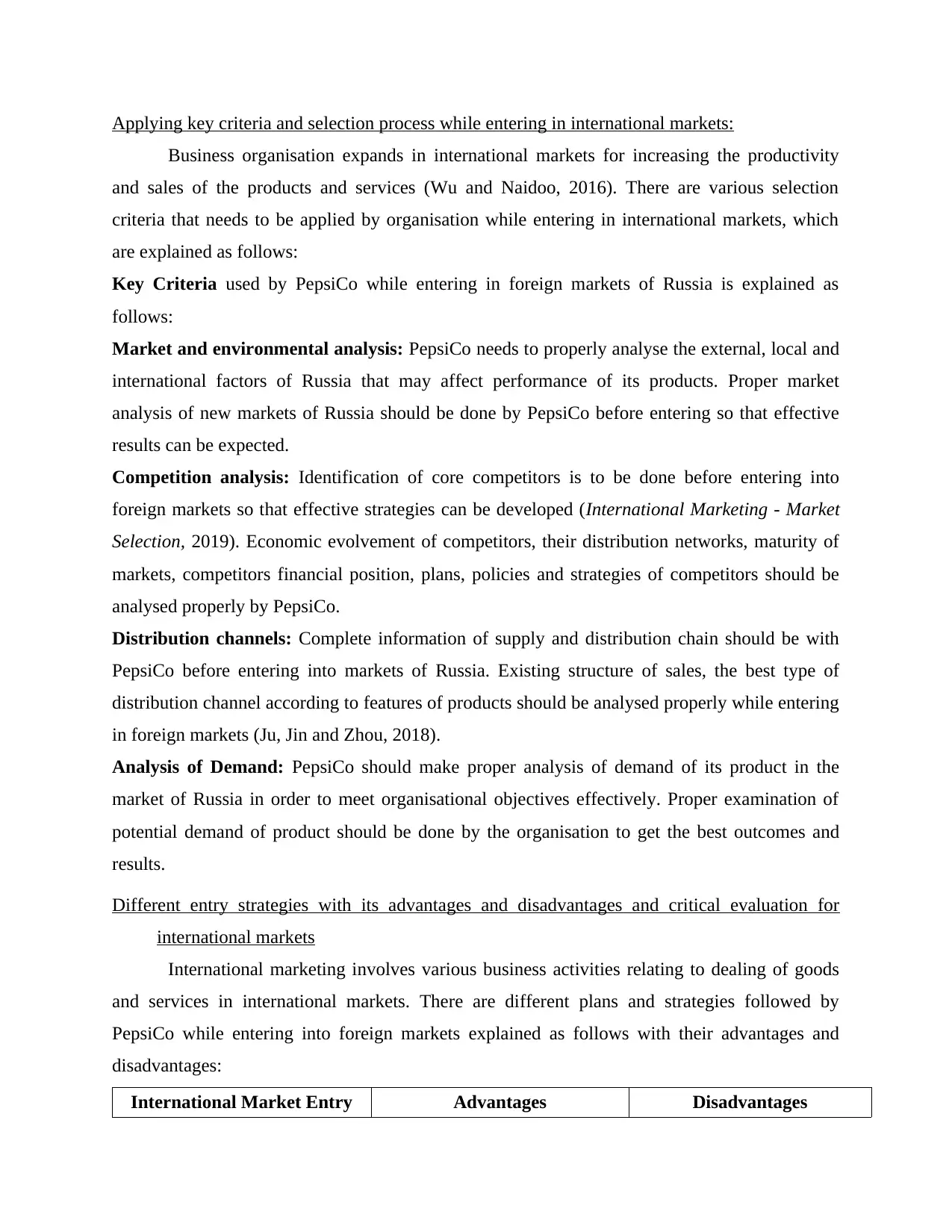
Applying key criteria and selection process while entering in international markets:
Business organisation expands in international markets for increasing the productivity
and sales of the products and services (Wu and Naidoo, 2016). There are various selection
criteria that needs to be applied by organisation while entering in international markets, which
are explained as follows:
Key Criteria used by PepsiCo while entering in foreign markets of Russia is explained as
follows:
Market and environmental analysis: PepsiCo needs to properly analyse the external, local and
international factors of Russia that may affect performance of its products. Proper market
analysis of new markets of Russia should be done by PepsiCo before entering so that effective
results can be expected.
Competition analysis: Identification of core competitors is to be done before entering into
foreign markets so that effective strategies can be developed (International Marketing - Market
Selection, 2019). Economic evolvement of competitors, their distribution networks, maturity of
markets, competitors financial position, plans, policies and strategies of competitors should be
analysed properly by PepsiCo.
Distribution channels: Complete information of supply and distribution chain should be with
PepsiCo before entering into markets of Russia. Existing structure of sales, the best type of
distribution channel according to features of products should be analysed properly while entering
in foreign markets (Ju, Jin and Zhou, 2018).
Analysis of Demand: PepsiCo should make proper analysis of demand of its product in the
market of Russia in order to meet organisational objectives effectively. Proper examination of
potential demand of product should be done by the organisation to get the best outcomes and
results.
Different entry strategies with its advantages and disadvantages and critical evaluation for
international markets
International marketing involves various business activities relating to dealing of goods
and services in international markets. There are different plans and strategies followed by
PepsiCo while entering into foreign markets explained as follows with their advantages and
disadvantages:
International Market Entry Advantages Disadvantages
Business organisation expands in international markets for increasing the productivity
and sales of the products and services (Wu and Naidoo, 2016). There are various selection
criteria that needs to be applied by organisation while entering in international markets, which
are explained as follows:
Key Criteria used by PepsiCo while entering in foreign markets of Russia is explained as
follows:
Market and environmental analysis: PepsiCo needs to properly analyse the external, local and
international factors of Russia that may affect performance of its products. Proper market
analysis of new markets of Russia should be done by PepsiCo before entering so that effective
results can be expected.
Competition analysis: Identification of core competitors is to be done before entering into
foreign markets so that effective strategies can be developed (International Marketing - Market
Selection, 2019). Economic evolvement of competitors, their distribution networks, maturity of
markets, competitors financial position, plans, policies and strategies of competitors should be
analysed properly by PepsiCo.
Distribution channels: Complete information of supply and distribution chain should be with
PepsiCo before entering into markets of Russia. Existing structure of sales, the best type of
distribution channel according to features of products should be analysed properly while entering
in foreign markets (Ju, Jin and Zhou, 2018).
Analysis of Demand: PepsiCo should make proper analysis of demand of its product in the
market of Russia in order to meet organisational objectives effectively. Proper examination of
potential demand of product should be done by the organisation to get the best outcomes and
results.
Different entry strategies with its advantages and disadvantages and critical evaluation for
international markets
International marketing involves various business activities relating to dealing of goods
and services in international markets. There are different plans and strategies followed by
PepsiCo while entering into foreign markets explained as follows with their advantages and
disadvantages:
International Market Entry Advantages Disadvantages
⊘ This is a preview!⊘
Do you want full access?
Subscribe today to unlock all pages.

Trusted by 1+ million students worldwide
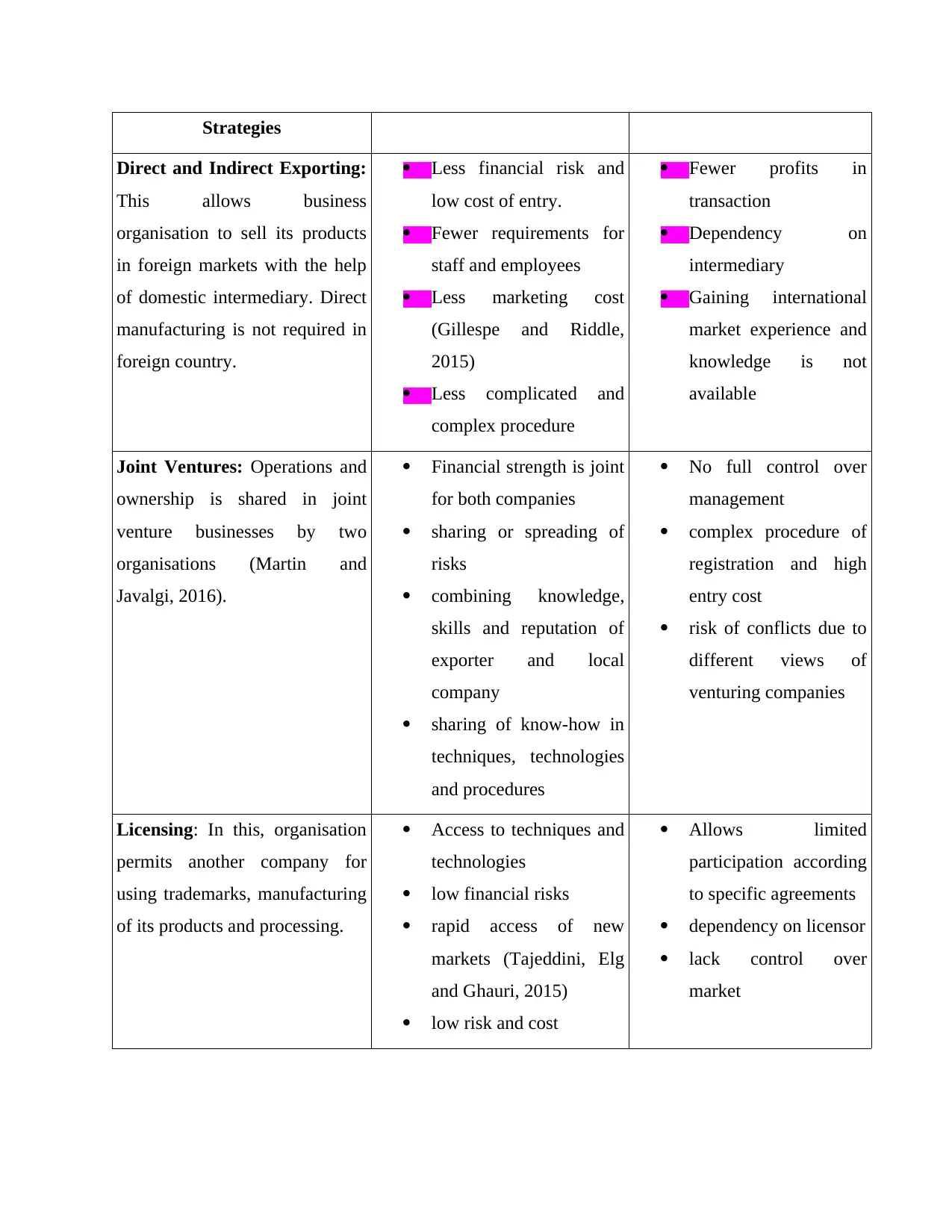
Strategies
Direct and Indirect Exporting:
This allows business
organisation to sell its products
in foreign markets with the help
of domestic intermediary. Direct
manufacturing is not required in
foreign country.
Less financial risk and
low cost of entry.
Fewer requirements for
staff and employees
Less marketing cost
(Gillespe and Riddle,
2015)
Less complicated and
complex procedure
Fewer profits in
transaction
Dependency on
intermediary
Gaining international
market experience and
knowledge is not
available
Joint Ventures: Operations and
ownership is shared in joint
venture businesses by two
organisations (Martin and
Javalgi, 2016).
Financial strength is joint
for both companies
sharing or spreading of
risks
combining knowledge,
skills and reputation of
exporter and local
company
sharing of know-how in
techniques, technologies
and procedures
No full control over
management
complex procedure of
registration and high
entry cost
risk of conflicts due to
different views of
venturing companies
Licensing: In this, organisation
permits another company for
using trademarks, manufacturing
of its products and processing.
Access to techniques and
technologies
low financial risks
rapid access of new
markets (Tajeddini, Elg
and Ghauri, 2015)
low risk and cost
Allows limited
participation according
to specific agreements
dependency on licensor
lack control over
market
Direct and Indirect Exporting:
This allows business
organisation to sell its products
in foreign markets with the help
of domestic intermediary. Direct
manufacturing is not required in
foreign country.
Less financial risk and
low cost of entry.
Fewer requirements for
staff and employees
Less marketing cost
(Gillespe and Riddle,
2015)
Less complicated and
complex procedure
Fewer profits in
transaction
Dependency on
intermediary
Gaining international
market experience and
knowledge is not
available
Joint Ventures: Operations and
ownership is shared in joint
venture businesses by two
organisations (Martin and
Javalgi, 2016).
Financial strength is joint
for both companies
sharing or spreading of
risks
combining knowledge,
skills and reputation of
exporter and local
company
sharing of know-how in
techniques, technologies
and procedures
No full control over
management
complex procedure of
registration and high
entry cost
risk of conflicts due to
different views of
venturing companies
Licensing: In this, organisation
permits another company for
using trademarks, manufacturing
of its products and processing.
Access to techniques and
technologies
low financial risks
rapid access of new
markets (Tajeddini, Elg
and Ghauri, 2015)
low risk and cost
Allows limited
participation according
to specific agreements
dependency on licensor
lack control over
market
Paraphrase This Document
Need a fresh take? Get an instant paraphrase of this document with our AI Paraphraser
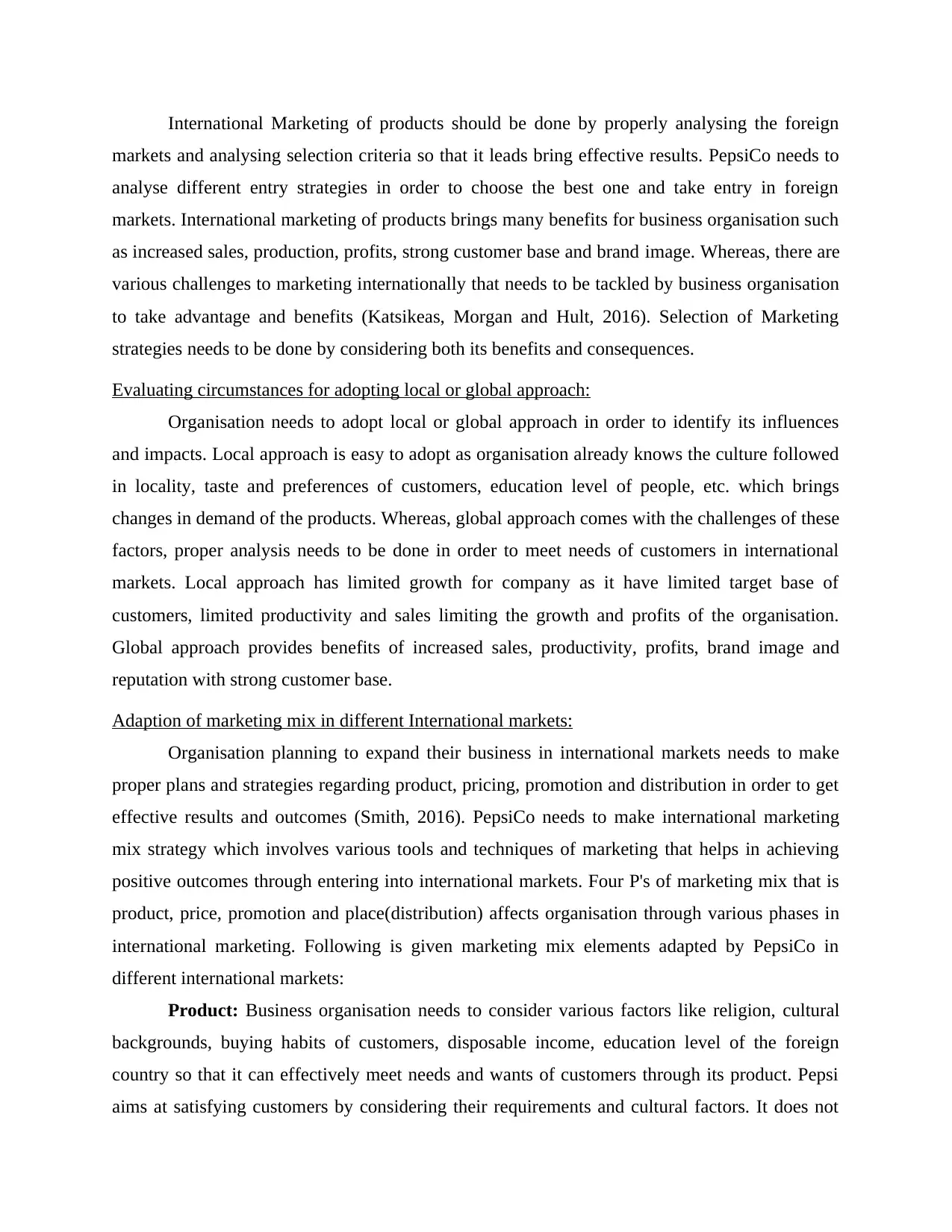
International Marketing of products should be done by properly analysing the foreign
markets and analysing selection criteria so that it leads bring effective results. PepsiCo needs to
analyse different entry strategies in order to choose the best one and take entry in foreign
markets. International marketing of products brings many benefits for business organisation such
as increased sales, production, profits, strong customer base and brand image. Whereas, there are
various challenges to marketing internationally that needs to be tackled by business organisation
to take advantage and benefits (Katsikeas, Morgan and Hult, 2016). Selection of Marketing
strategies needs to be done by considering both its benefits and consequences.
Evaluating circumstances for adopting local or global approach:
Organisation needs to adopt local or global approach in order to identify its influences
and impacts. Local approach is easy to adopt as organisation already knows the culture followed
in locality, taste and preferences of customers, education level of people, etc. which brings
changes in demand of the products. Whereas, global approach comes with the challenges of these
factors, proper analysis needs to be done in order to meet needs of customers in international
markets. Local approach has limited growth for company as it have limited target base of
customers, limited productivity and sales limiting the growth and profits of the organisation.
Global approach provides benefits of increased sales, productivity, profits, brand image and
reputation with strong customer base.
Adaption of marketing mix in different International markets:
Organisation planning to expand their business in international markets needs to make
proper plans and strategies regarding product, pricing, promotion and distribution in order to get
effective results and outcomes (Smith, 2016). PepsiCo needs to make international marketing
mix strategy which involves various tools and techniques of marketing that helps in achieving
positive outcomes through entering into international markets. Four P's of marketing mix that is
product, price, promotion and place(distribution) affects organisation through various phases in
international marketing. Following is given marketing mix elements adapted by PepsiCo in
different international markets:
Product: Business organisation needs to consider various factors like religion, cultural
backgrounds, buying habits of customers, disposable income, education level of the foreign
country so that it can effectively meet needs and wants of customers through its product. Pepsi
aims at satisfying customers by considering their requirements and cultural factors. It does not
markets and analysing selection criteria so that it leads bring effective results. PepsiCo needs to
analyse different entry strategies in order to choose the best one and take entry in foreign
markets. International marketing of products brings many benefits for business organisation such
as increased sales, production, profits, strong customer base and brand image. Whereas, there are
various challenges to marketing internationally that needs to be tackled by business organisation
to take advantage and benefits (Katsikeas, Morgan and Hult, 2016). Selection of Marketing
strategies needs to be done by considering both its benefits and consequences.
Evaluating circumstances for adopting local or global approach:
Organisation needs to adopt local or global approach in order to identify its influences
and impacts. Local approach is easy to adopt as organisation already knows the culture followed
in locality, taste and preferences of customers, education level of people, etc. which brings
changes in demand of the products. Whereas, global approach comes with the challenges of these
factors, proper analysis needs to be done in order to meet needs of customers in international
markets. Local approach has limited growth for company as it have limited target base of
customers, limited productivity and sales limiting the growth and profits of the organisation.
Global approach provides benefits of increased sales, productivity, profits, brand image and
reputation with strong customer base.
Adaption of marketing mix in different International markets:
Organisation planning to expand their business in international markets needs to make
proper plans and strategies regarding product, pricing, promotion and distribution in order to get
effective results and outcomes (Smith, 2016). PepsiCo needs to make international marketing
mix strategy which involves various tools and techniques of marketing that helps in achieving
positive outcomes through entering into international markets. Four P's of marketing mix that is
product, price, promotion and place(distribution) affects organisation through various phases in
international marketing. Following is given marketing mix elements adapted by PepsiCo in
different international markets:
Product: Business organisation needs to consider various factors like religion, cultural
backgrounds, buying habits of customers, disposable income, education level of the foreign
country so that it can effectively meet needs and wants of customers through its product. Pepsi
aims at satisfying customers by considering their requirements and cultural factors. It does not
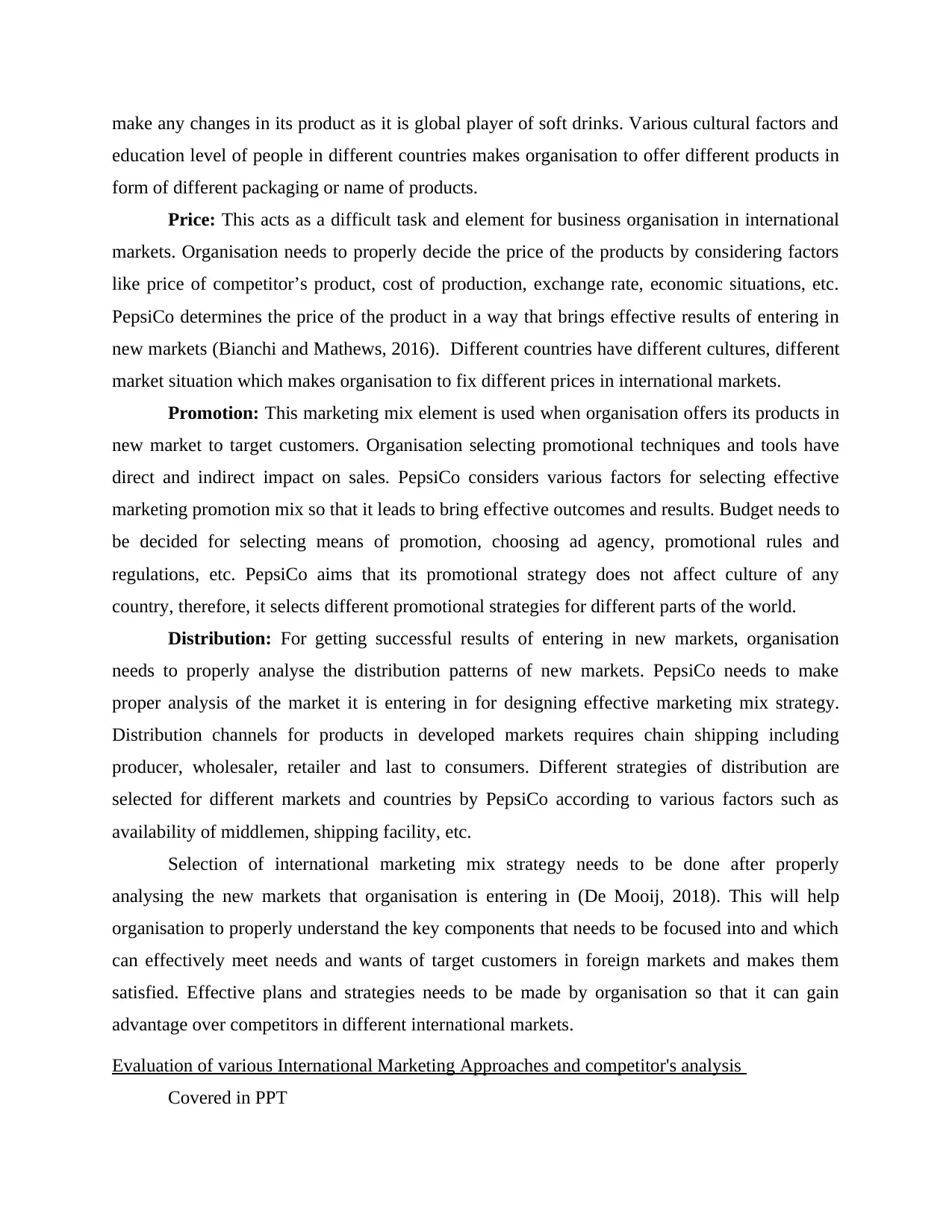
make any changes in its product as it is global player of soft drinks. Various cultural factors and
education level of people in different countries makes organisation to offer different products in
form of different packaging or name of products.
Price: This acts as a difficult task and element for business organisation in international
markets. Organisation needs to properly decide the price of the products by considering factors
like price of competitor’s product, cost of production, exchange rate, economic situations, etc.
PepsiCo determines the price of the product in a way that brings effective results of entering in
new markets (Bianchi and Mathews, 2016). Different countries have different cultures, different
market situation which makes organisation to fix different prices in international markets.
Promotion: This marketing mix element is used when organisation offers its products in
new market to target customers. Organisation selecting promotional techniques and tools have
direct and indirect impact on sales. PepsiCo considers various factors for selecting effective
marketing promotion mix so that it leads to bring effective outcomes and results. Budget needs to
be decided for selecting means of promotion, choosing ad agency, promotional rules and
regulations, etc. PepsiCo aims that its promotional strategy does not affect culture of any
country, therefore, it selects different promotional strategies for different parts of the world.
Distribution: For getting successful results of entering in new markets, organisation
needs to properly analyse the distribution patterns of new markets. PepsiCo needs to make
proper analysis of the market it is entering in for designing effective marketing mix strategy.
Distribution channels for products in developed markets requires chain shipping including
producer, wholesaler, retailer and last to consumers. Different strategies of distribution are
selected for different markets and countries by PepsiCo according to various factors such as
availability of middlemen, shipping facility, etc.
Selection of international marketing mix strategy needs to be done after properly
analysing the new markets that organisation is entering in (De Mooij, 2018). This will help
organisation to properly understand the key components that needs to be focused into and which
can effectively meet needs and wants of target customers in foreign markets and makes them
satisfied. Effective plans and strategies needs to be made by organisation so that it can gain
advantage over competitors in different international markets.
Evaluation of various International Marketing Approaches and competitor's analysis
Covered in PPT
education level of people in different countries makes organisation to offer different products in
form of different packaging or name of products.
Price: This acts as a difficult task and element for business organisation in international
markets. Organisation needs to properly decide the price of the products by considering factors
like price of competitor’s product, cost of production, exchange rate, economic situations, etc.
PepsiCo determines the price of the product in a way that brings effective results of entering in
new markets (Bianchi and Mathews, 2016). Different countries have different cultures, different
market situation which makes organisation to fix different prices in international markets.
Promotion: This marketing mix element is used when organisation offers its products in
new market to target customers. Organisation selecting promotional techniques and tools have
direct and indirect impact on sales. PepsiCo considers various factors for selecting effective
marketing promotion mix so that it leads to bring effective outcomes and results. Budget needs to
be decided for selecting means of promotion, choosing ad agency, promotional rules and
regulations, etc. PepsiCo aims that its promotional strategy does not affect culture of any
country, therefore, it selects different promotional strategies for different parts of the world.
Distribution: For getting successful results of entering in new markets, organisation
needs to properly analyse the distribution patterns of new markets. PepsiCo needs to make
proper analysis of the market it is entering in for designing effective marketing mix strategy.
Distribution channels for products in developed markets requires chain shipping including
producer, wholesaler, retailer and last to consumers. Different strategies of distribution are
selected for different markets and countries by PepsiCo according to various factors such as
availability of middlemen, shipping facility, etc.
Selection of international marketing mix strategy needs to be done after properly
analysing the new markets that organisation is entering in (De Mooij, 2018). This will help
organisation to properly understand the key components that needs to be focused into and which
can effectively meet needs and wants of target customers in foreign markets and makes them
satisfied. Effective plans and strategies needs to be made by organisation so that it can gain
advantage over competitors in different international markets.
Evaluation of various International Marketing Approaches and competitor's analysis
Covered in PPT
⊘ This is a preview!⊘
Do you want full access?
Subscribe today to unlock all pages.

Trusted by 1+ million students worldwide
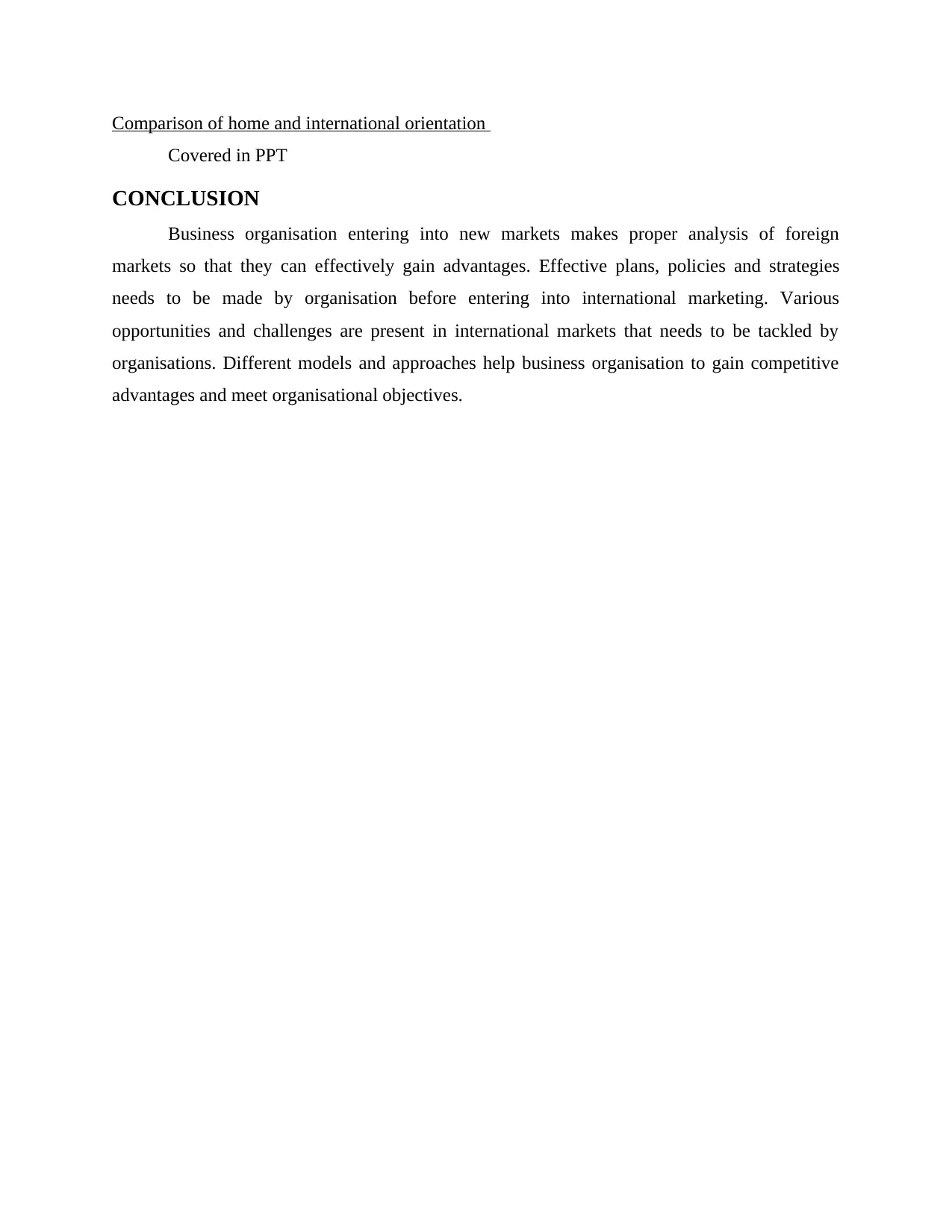
Comparison of home and international orientation
Covered in PPT
CONCLUSION
Business organisation entering into new markets makes proper analysis of foreign
markets so that they can effectively gain advantages. Effective plans, policies and strategies
needs to be made by organisation before entering into international marketing. Various
opportunities and challenges are present in international markets that needs to be tackled by
organisations. Different models and approaches help business organisation to gain competitive
advantages and meet organisational objectives.
Covered in PPT
CONCLUSION
Business organisation entering into new markets makes proper analysis of foreign
markets so that they can effectively gain advantages. Effective plans, policies and strategies
needs to be made by organisation before entering into international marketing. Various
opportunities and challenges are present in international markets that needs to be tackled by
organisations. Different models and approaches help business organisation to gain competitive
advantages and meet organisational objectives.
Paraphrase This Document
Need a fresh take? Get an instant paraphrase of this document with our AI Paraphraser

REFERENCES
Books And Journal
Amankwah-Amoah, J., Boso, N. and Debrah, Y. A., 2018. Africa rising in an emerging world:
an international marketing perspective. International Marketing Review. 35(4). pp.550-
559.
Bianchi, C. and Mathews, S., 2016. Internet marketing and export market growth in Chile.
Journal of Business Research. 69(2). pp.426-434.
De Mooij, M., 2018. Global marketing and advertising: Understanding cultural paradoxes.
SAGE Publications Limited.
Eteokleous, P. P., Leonidou, L. C. and Katsikeas, C. S., 2016. Corporate social responsibility in
international marketing: review, assessment, and future research. International
Marketing Review. 33(4). pp.580-624.
Gillespie, K. and Riddle, L., 2015. Global marketing. Routledge.
Ju, M., Jin, J. L. and Zhou, K. Z., 2018. How can international ventures utilize marketing
capability in emerging markets? Its contingent effect on new product development.
Journal of International Marketing. 26(4). pp.1-17.
Katsikeas, C. S., Morgan, N. A. and Hult, G. T. M., 2016. Assessing performance outcomes in
marketing. Journal of Marketing. 80(2). pp.1-20.
Martin, S. L. and Javalgi, R. R. G., 2016. Entrepreneurial orientation, marketing capabilities and
performance: The moderating role of competitive intensity on Latin American
international new ventures. Journal of Business Research. 69(6). pp.2040-2051.
Morschett, D., Schramm-Klein, H. and Zentes, J., 2015. Strategic international management (pp.
978-3658078836). Springer.
Smith, B., 2016. Nature and Geography: Tragic Voids within Marketing Textbooks and the
External Business Environment. In Global Perspectives on Contemporary Marketing
Education (pp. 47-64). IGI Global.
Tajeddini, K., Elg, U. and Ghauri, P. N., 2015. Enhancing organizational performance of
international SMEs through inter-firm marketing collaborations. In International
Marketing in the Fast Changing World (pp. 109-133). Emerald Group Publishing
Limited.
Books And Journal
Amankwah-Amoah, J., Boso, N. and Debrah, Y. A., 2018. Africa rising in an emerging world:
an international marketing perspective. International Marketing Review. 35(4). pp.550-
559.
Bianchi, C. and Mathews, S., 2016. Internet marketing and export market growth in Chile.
Journal of Business Research. 69(2). pp.426-434.
De Mooij, M., 2018. Global marketing and advertising: Understanding cultural paradoxes.
SAGE Publications Limited.
Eteokleous, P. P., Leonidou, L. C. and Katsikeas, C. S., 2016. Corporate social responsibility in
international marketing: review, assessment, and future research. International
Marketing Review. 33(4). pp.580-624.
Gillespie, K. and Riddle, L., 2015. Global marketing. Routledge.
Ju, M., Jin, J. L. and Zhou, K. Z., 2018. How can international ventures utilize marketing
capability in emerging markets? Its contingent effect on new product development.
Journal of International Marketing. 26(4). pp.1-17.
Katsikeas, C. S., Morgan, N. A. and Hult, G. T. M., 2016. Assessing performance outcomes in
marketing. Journal of Marketing. 80(2). pp.1-20.
Martin, S. L. and Javalgi, R. R. G., 2016. Entrepreneurial orientation, marketing capabilities and
performance: The moderating role of competitive intensity on Latin American
international new ventures. Journal of Business Research. 69(6). pp.2040-2051.
Morschett, D., Schramm-Klein, H. and Zentes, J., 2015. Strategic international management (pp.
978-3658078836). Springer.
Smith, B., 2016. Nature and Geography: Tragic Voids within Marketing Textbooks and the
External Business Environment. In Global Perspectives on Contemporary Marketing
Education (pp. 47-64). IGI Global.
Tajeddini, K., Elg, U. and Ghauri, P. N., 2015. Enhancing organizational performance of
international SMEs through inter-firm marketing collaborations. In International
Marketing in the Fast Changing World (pp. 109-133). Emerald Group Publishing
Limited.
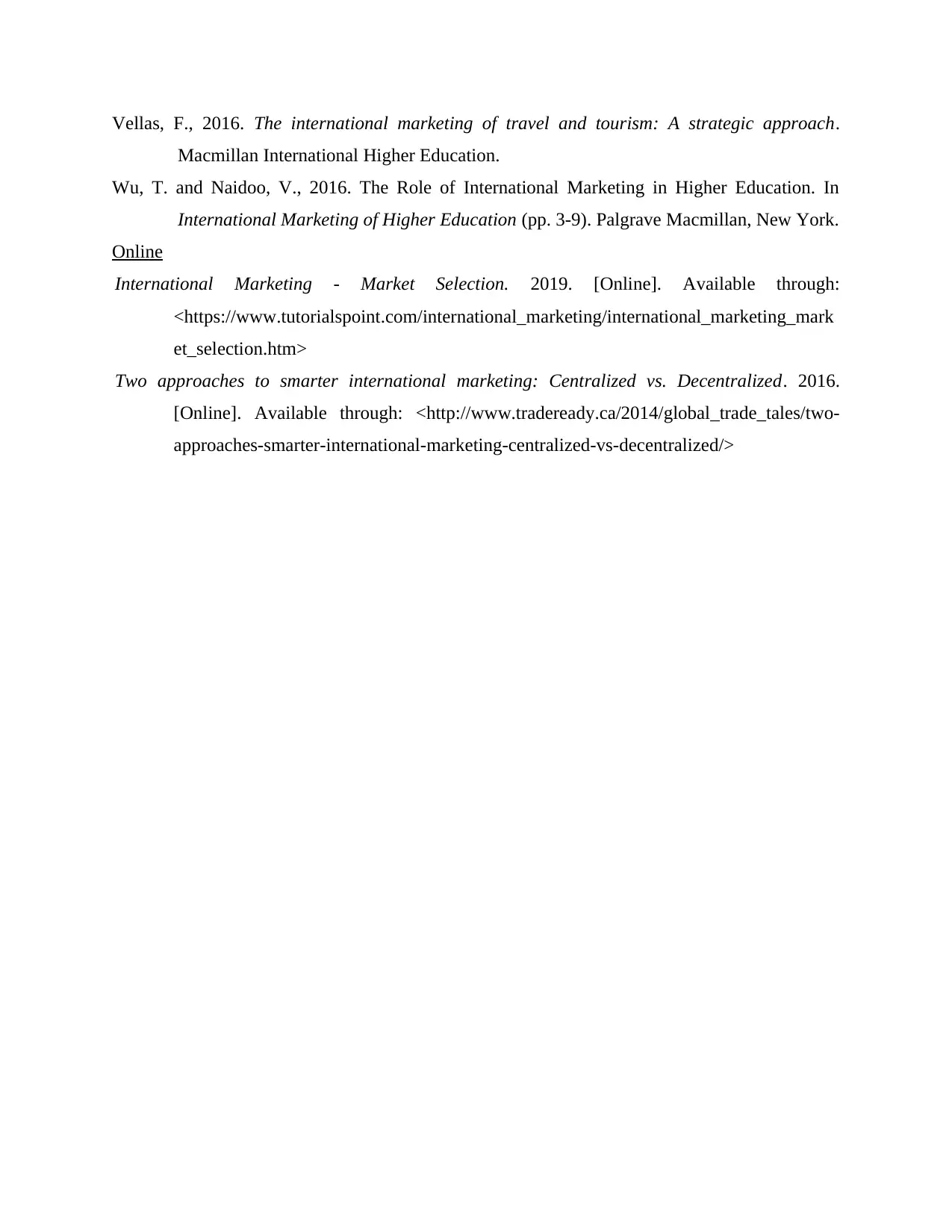
Vellas, F., 2016. The international marketing of travel and tourism: A strategic approach.
Macmillan International Higher Education.
Wu, T. and Naidoo, V., 2016. The Role of International Marketing in Higher Education. In
International Marketing of Higher Education (pp. 3-9). Palgrave Macmillan, New York.
Online
International Marketing - Market Selection. 2019. [Online]. Available through:
<https://www.tutorialspoint.com/international_marketing/international_marketing_mark
et_selection.htm>
Two approaches to smarter international marketing: Centralized vs. Decentralized. 2016.
[Online]. Available through: <http://www.tradeready.ca/2014/global_trade_tales/two-
approaches-smarter-international-marketing-centralized-vs-decentralized/>
Macmillan International Higher Education.
Wu, T. and Naidoo, V., 2016. The Role of International Marketing in Higher Education. In
International Marketing of Higher Education (pp. 3-9). Palgrave Macmillan, New York.
Online
International Marketing - Market Selection. 2019. [Online]. Available through:
<https://www.tutorialspoint.com/international_marketing/international_marketing_mark
et_selection.htm>
Two approaches to smarter international marketing: Centralized vs. Decentralized. 2016.
[Online]. Available through: <http://www.tradeready.ca/2014/global_trade_tales/two-
approaches-smarter-international-marketing-centralized-vs-decentralized/>
⊘ This is a preview!⊘
Do you want full access?
Subscribe today to unlock all pages.

Trusted by 1+ million students worldwide
1 out of 12
Related Documents
Your All-in-One AI-Powered Toolkit for Academic Success.
+13062052269
info@desklib.com
Available 24*7 on WhatsApp / Email
![[object Object]](/_next/static/media/star-bottom.7253800d.svg)
Unlock your academic potential
Copyright © 2020–2025 A2Z Services. All Rights Reserved. Developed and managed by ZUCOL.





